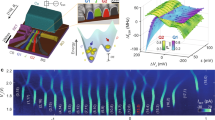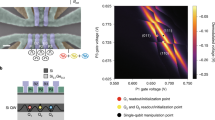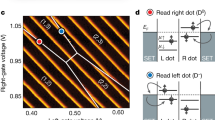Abstract
Bell's theorem proves the existence of entangled quantum states with no classical counterpart1. An experimental violation of Bell's inequality demands simultaneously high fidelities in the preparation, manipulation and measurement of multipartite quantum entangled states, and provides a single-number benchmark for the performance of devices that use such states for quantum computing2,3,4. We demonstrate a Bell/ Clauser–Horne–Shimony–Holt inequality5 violation with Bell signals up to 2.70(9), using the electron and the nuclear spins of a single phosphorus atom embedded in a silicon nanoelectronic device. Two-qubit state tomography reveals that our prepared states match the target maximally entangled Bell states with >96% fidelity. These experiments demonstrate complete control of the two-qubit Hilbert space of a phosphorus atom and highlight the important function of the nuclear qubit to expand the computational basis and maximize the readout fidelity.
This is a preview of subscription content, access via your institution
Access options
Subscribe to this journal
Receive 12 print issues and online access
$259.00 per year
only $21.58 per issue
Buy this article
- Purchase on Springer Link
- Instant access to full article PDF
Prices may be subject to local taxes which are calculated during checkout



Similar content being viewed by others
References
Bell, J. S. On the Einstein Podolski Rosen paradox. Physics 1, 195–200 (1964).
Rowe, M. A. et al. Experimental violation of a Bell's inequality with efficient detection. Nature 409, 791–794 (2001).
Ansmann, M. et al. Violation of Bell's inequality in Josephson phase qubits. Nature 461, 504–506 (2009).
Pfaff, W. et al. Demonstration of entanglement-by-measurement of solid-state qubits. Nature Phys. 9, 29–33 (2012).
Clauser, J., Horne, M., Shimony, A. & Holt, R. Proposed experiment to test local hidden-variable theories. Phys. Rev. Lett. 23, 880–884 (1969).
Aspect, A., Dalibard, J. & Roger, G. Experimental test of Bell's inequalities using time-varying analyzers. Phys. Rev. Lett. 49, 1804–1807 (1982).
Weihs, G., Jennewein, T., Simon, C., Weinfurter, H. & Zeilinger, A. Violation of Bell's inequality under strict Einstein locality conditions. Phys. Rev. Lett. 81, 5039–5043 (1998).
Bennett, C. H. & DiVincenzo, D. P. Quantum information and computation. Nature 404, 247–255 (2000).
Ghosh, S., Rosenbaum, T. F., Aeppli, G. & Coppersmith, S. N. Entangled quantum state of magnetic dipoles. Nature 425, 48–51 (2003).
Neumann, P. et al. Multipartite entanglement among single spins in diamond. Science 320, 1326–1329 (2008).
Simmons, S. et al. Entanglement in a solid-state spin ensemble. Nature 470, 69–72 (2011).
Brunner, R. et al. Two-qubit gate of combined single-spin rotation and interdot spin exchange in a double quantum dot. Phys. Rev. Lett. 107, 146801 (2011).
Shulman, M. D. et al. Demonstration of entanglement of electrostatically coupled singlet–triplet qubits. Science 336, 202–205 (2012).
Bernien, H. et al. Heralded entanglement between solid-state qubits separated by three metres. Nature 497, 86–90 (2013).
Peres, A. Separability criterion for density matrices. Phys. Rev. Lett. 77, 1413–1415 (1996).
van Donkelaar, J. et al. Single atom devices by ion implantation. J. Phys. 27, 154204 (2015).
Muhonen, J. T. et al. Storing quantum information for 30 seconds in a nanoelectronic device. Nature Nanotech. 9, 986–991 (2014).
Itoh, K. M. & Watanabe, H. Isotope engineering of silicon and diamond for quantum computing and sensing applications. MRS Commun. 4, 143–157 (2014).
Laucht, A. et al. Electrically controlling single-spin qubits in a continuous microwave field. Sci. Adv. 1, e1500022 (2015).
Dehollain, J. P. et al. Nanoscale broadband transmission lines for spin qubit control. Nanotechnology 24, 015202 (2013).
Morello, A. et al. Single-shot readout of an electron spin in silicon. Nature 467, 687–691 (2010).
Dutt, M. V. G. et al. Quantum register based on individual electronic and nuclear spin qubits in diamond. Science 316, 1312–1316 (2007).
Pla, J. J. et al. A single-atom electron spin qubit in silicon. Nature 489, 541–545 (2012).
Pla, J. J. et al. High-fidelity readout and control of a nuclear spin qubit in silicon. Nature 496, 334–338 (2013).
Larsson, J.-Å. Loopholes in Bell inequality tests of local realism. J. Phys. A 47, 424003 (2014).
Mehring, M., Mende, J. & Scherer, W. Entanglement between an electron and a nuclear spin 1/2. Phys. Rev. Lett. 90, 153001 (2003).
Hill, S. & Wootters, W. Entanglement of a pair of quantum bits. Phys. Rev. Lett. 78, 5022–5025 (1997).
Morley, G. W. et al. The initialization and manipulation of quantum information stored in silicon by bismuth dopants. Nature Mater. 9, 725–729 (2010).
Barrett, J., Cavalcanti, E. G., Lal, R. & Maroney, O. J. E. No Ψ-epistemic model can fully explain the indistinguishability of quantum states. Phys. Rev. Lett. 112, 250403 (2014).
Kalra, R., Laucht, A., Hill, C. D. & Morello, A. Robust two-qubit gates for donors in silicon controlled by hyperfine interactions. Phys. Rev. X 4, 021044 (2014).
Acknowledgements
This research was funded by the Australian Research Council Centre of Excellence for Quantum Computation and Communication Technology (project no. CE110001027) and the US Army Research Office (W911NF-13-1-0024). The authors acknowledge support from the Australian National Fabrication Facility. The work at Keio was supported in part by a Grant-in-Aid for Scientific Research by MEXT, in part by NanoQuine, in part by FIRST, and in part by a JSPS Core-to-Core Program.
Author information
Authors and Affiliations
Contributions
J.P.D. and S.S. contributed equally to this work, designing and carrying out the experiments, and analysing the data, with A.M.'s supervision. J.P.D., J.T.M., A.L. and A.M. designed and constructed the experimental set-up. R.K. and F.H. fabricated the device with A.S.D.'s supervision. K.M.I. supplied the 28Si wafers. D.N.J. and J.C.M. designed and carried out the 31P ion implantation with R.K.’s help. J.P.D., S.S. and A.M. wrote the manuscript with feedback from all authors.
Corresponding author
Ethics declarations
Competing interests
The authors declare no competing financial interests.
Supplementary information
Supplementary information
Supplementary information (PDF 1211 kb)
Rights and permissions
About this article
Cite this article
Dehollain, J., Simmons, S., Muhonen, J. et al. Bell's inequality violation with spins in silicon. Nature Nanotech 11, 242–246 (2016). https://doi.org/10.1038/nnano.2015.262
Received:
Accepted:
Published:
Issue Date:
DOI: https://doi.org/10.1038/nnano.2015.262
This article is cited by
-
Probing two-qubit capacitive interactions beyond bilinear regime using dual Hamiltonian parameter estimations
npj Quantum Information (2023)
-
Towards entanglement distillation between atomic ensembles using high-fidelity spin operations
Communications Physics (2022)
-
Semiconductor qubits in practice
Nature Reviews Physics (2021)
-
Coherent spin qubit transport in silicon
Nature Communications (2021)
-
Quantum-coherent nanoscience
Nature Nanotechnology (2021)



